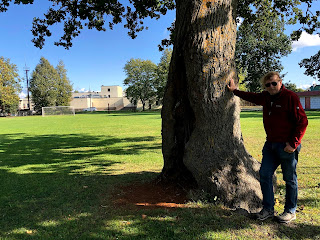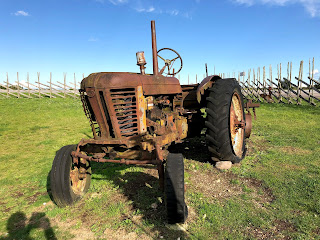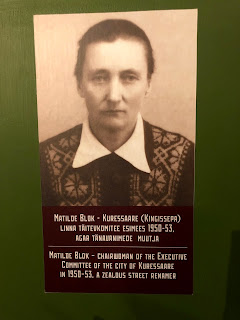Today rain nearly stopped play. A persistent driving downpour started before dawn, and hardly stopped before four o'clock this afternoon. Luckily, we were able to take refuge in the keep of Kuressaare castle with its eclectic collection of displays ranging from dodgy stuffed wildlife to a fascinating and chilling retelling of Saaremaa island's extraordinary role in the 1940s as the rattle between Germany's Tweedledum and Russia's Tweedledee. A third of the population perished as a result.
 |
| Mustn't let the Tsar and his family get wet |
Our water tank was almost empty, having not been filled up since leaving Tallinn, so we elected to pay for the first time to fill up at the fuel station in town - 5c a litre. We then pushed on to Virtsu, and the ferry to Saaremaa, now a popular holiday destination for people from Tallinn, but for many years closed to outsiders as a Soviet defence stronghold. The ferry was modern and rather posh compared to some of those we'd become used to in Norway, and the cafeteria, shop and comfortable seating meant we were taken by surprise when invited to return to our vehicles barely 20 minutes after leaving them.
The ferry arrives in Muhu, a small island between Saaremaa and the mainland, and there is a causeway between Muhu and Saaremaa. A short lunch stop at the causeway informed us that the islands had held out against Christianity longer than most of Europe, but the last group of pagans had been massacred by the crusading Brothers of the Sword in the 1340s. It also described the building of the causeway in the late nineteenth century, and how when money was finally made available work progressed much more quickly than expected as the locals construction workers were paid by the yard.
 |
| The tree makes a great defender |
A detour for supplies in the Co-op at Orissaare allowed us a quick visit to the town football pitch, which is unique for having an oak tree in the middle of it. The sports field was built with the tree still standing, on the expectation that the tree would be felled before completion. However, the tree was not inclined to comply, and despite scars and scorch marks in its hollowed-out trunk, it is there to this day.
 |
| Who do we know interested in gravestones? |
 |
| Another seaside picnic spot |
 |
| They don't pull their punches here |
 |
| A short history of tractors in Estonia |
 |
| The Soviet section |
 |
| "A zealous street renamer" Ouch. |



I like the zealous street renamer, it sounds terrifying .
ReplyDeleteI thought Richard might take an interest in the zealous street renamer Julie. 🤣
DeleteThe museums you are visiting recently sound to be a mixture of the ridiculous to the sublime, but fascinating.
ReplyDeleteHopefully you will get some dry weather now. Wet dogs and wet, wet weather gear no fun for any length of time. 😉